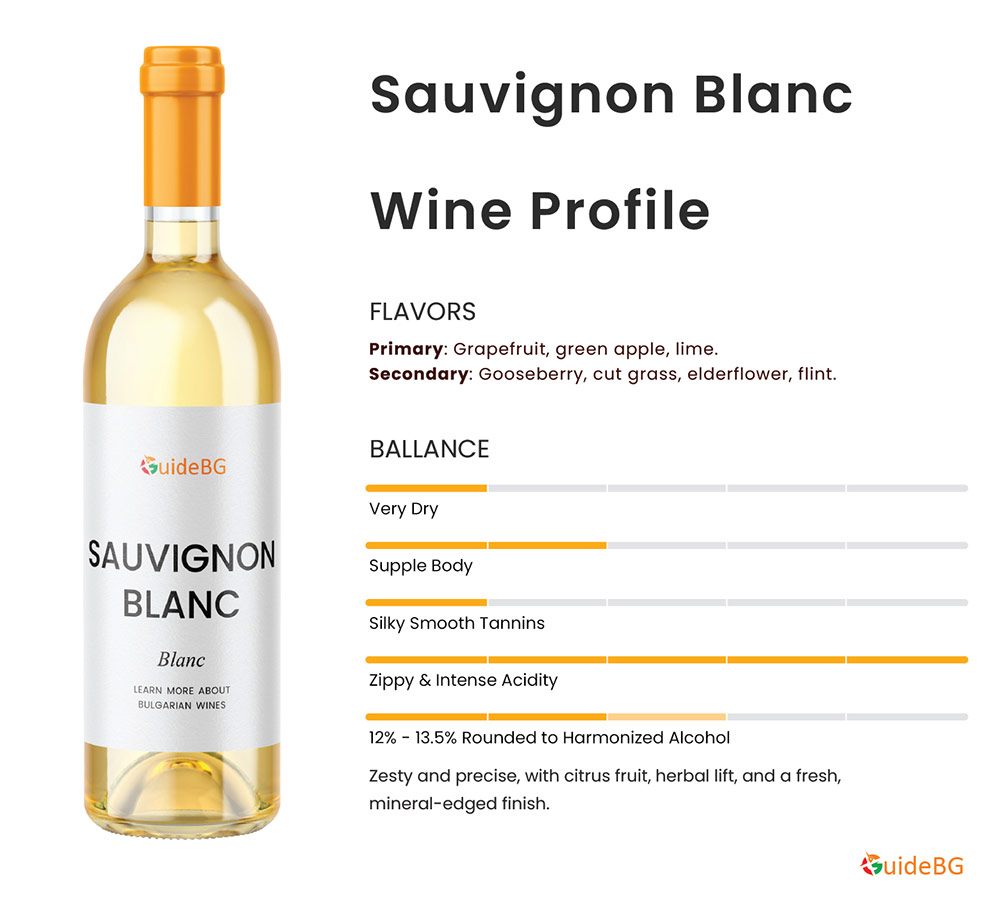Sauvignon Blanc is one of the world’s most widely recognized white grape varieties. In Bulgaria, it has firmly established itself across a range of wine-growing regions. Introduced in the 20th century, Sauvignon Blanc has proven highly adaptable to Bulgaria’s varied climates, from the cool, breezy Black Sea Coast to the sun-drenched southern valleys and higher-altitude northern hills.
Bulgarian Sauvignon Blanc wines are known for their crisp acidity, vibrant aromatics, and expressive fruit. Regional styles range from zesty and citrus-driven to tropical, grassy, or even mineral. Increasingly, they are featured as single-varietal wines but appear in blends or as key players in modern Bulgarian whites.

Zesty and aromatic, Bulgarian Sauvignon Blanc bursts with grapefruit, lime, and green apple, lifted by gooseberry, elderflower, and a hint of flinty minerality. Its bright acidity, supple body, and clean finish make it a refreshing, food-friendly white wine.
Serving
7 – 9°C

Aroma white

Serve fresh

Food Pairing
Salads & Light Dishes
Caesar salad, green salads with vinaigrette, herbed couscous, fresh tabbouleh
Fish & Seafood
White fish (grilled, poached, smoked, or baked), sea bass, trout, and scallops with citrus butter
Poultry
Roasted or grilled chicken, chicken salad, lemon-herb chicken skewers
Creamy or Rich Dishes
Cordon bleu, veal in creamy sauce, chicken fricassée, creamy mushroom tagliatelle
Charcuterie
Pork ham, lean prosciutto, white pâté, mild cured meats
Pasta & Vegetarian
Tomato-based pasta sauces, grilled vegetable lasagna, ratatouille
Cheese Pairings
Fresh goat cheese, feta, ricotta, and aromatic blue cheese like Roquefort or Gorgonzola
Fruits & Fresh Pairings
Fresh pears, green apples, melon with herbs
Spicy Dishes
Thai green curry, spicy shrimp, chili lime chicken, or Mexican dishes with cilantro and lime
What to Look For?
Look for a pale lemon-green hue, bright citrus and grassy aromas, and a lean, vibrant palate with saline or stony notes in coastal examples. High acidity and precise aromatics are key identifiers.
Cellaring Potential
Best enjoyed young (1–3 years) while its freshness and aromatics are at their peak. Some structured or oak-aged expressions may age slightly longer.
Blending Partners
Sometimes blended with:
- Semillon or Chardonnay for weight
- Muscat Ottonel or Tamyanka for aromatic layering
- Occasionally, part of the white PGI blends
Regional Expressions
While this article presents a national overview, Bulgaria’s Sauvignon Blanc also shows a strong regional identity. Notable styles include:
Black Sea Coast
- Bright and salty, with lime zest, green herbs, and sea spray notes
- Excellent with seafood and coastal cuisine
Thracian Lowlands
- Riper styles, with tropical fruit, elderflower, and a rounder texture
- Sometimes oak-aged or blended for complexity
Danubian Plain
- High-altitude freshness, showing green apple, white peach, and crisp, lifted structure
- Elegant and mineral, often unoaked
Alternative Grapes
Try Vrachanski Misket, Misket Varnenski, or Dimyat for similar freshness and vibrancy. Internationally, compare with Verdejo, Albariño, or Pinot Grigio.


